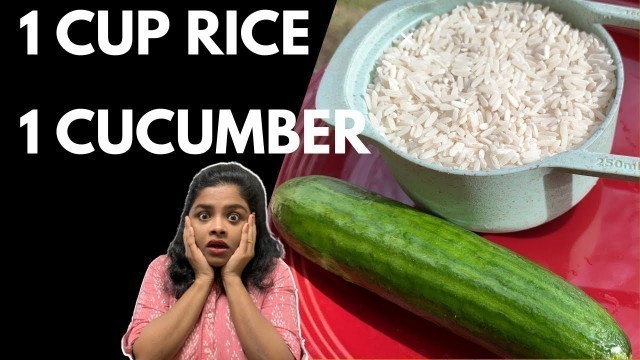

'Dosa is eaten over by 250+ million people in Southern India as a staple food. So, can you imagine the benefits of it? In this video I am sharing a simple recipe which just needs 2 Main ingredients. Ingredients 1 + ½ Cup of raw rice 3 small cucumbers ½ Cup cooked rice 1/4th of an onion 1 TBSP cumin or Jeera ½ tbsp salt Few drops of clarified Butter / Ghee Soak the rice for minimum 4 hours. Mix all the ingredients in a blender and leave it over a countertop for fermentation After 10 /12 hours of fermentation you can pour out the batter and make thin dosa or crepe on a hot cast iron pan or non stick pan. Serve hot with Chutneys or pickles. What is Fermentation? Fermentation is the process of converting carbohydrates to alcohol or organic acids with the help of microorganisms. Fermented food simply means that the food is left to sit and steep until the sugars and carbohydrates that the food naturally contains interact with bacteria, yeast and microbes to change the chemical structure of the food. A huge range of fermented foods exist, from yogurt, sauerkraut, and kimchi to the Indian fermented foods like 1. Made from cereals and/or pulses – Idli, dosa, Ambala, nan, pazhaya, etc. 2. Buttermilk based including cereal/pulses – Kadi, Kulu, Mor Kuzhambu, etc. 3. Fermented sweets and snacks – Tiskari, jalebi, Bhatura, Torani, Changpa, Thuktal, etc. 4. Made from milk – Curd, Philuk, Somar, Chhu, Chirpin, etc. 5. Made from unripe fruits, bamboo shoots, vegetables – sauerkraut, Iromba, Meshu, Goyang, Gundruk, Sinki, Khorisa-Tenga, etc. 6. Made from meat products – Yak Satchu, Hentak, Lona Ilish, Uttonggari, etc. 7. Made from pulses – Bedwin roti, dhokla, khaman, Madrah, wadi, Bekanthu, Hawaijar, etc. INTERESTING FACTS ABOUT DOSA BATTER: Fermentation of dosa batter is carried out mainly by Lactobacillales or lactic acid bacteria (bacteria that convert milk to yogurt) In the early stages of fermentation, the ‘heterofermentative’ type bacteria like Leuconostoc mesenteroides are found to predominate, producing carbon dioxide and alcohol along with the lactic acid (the mucilaginous property of dosa batter helps to trap the carbon-dioxide evolved during fermentation which results into leavening of the batter). During the later stages of the fermentation the homofermentative lactic acid bacteria like Lactococcus lactis (Fig. 4) dominate and produce only lactic acid. Due to this batter starts turning sour over the time. This is why fermented batter should be consumed within a day or 2 as it starts to get sour over the time. Can we avoid SALT in this recipe? Presence of salt helps to control the fermentation process. It slows down the yeast action and helps the liberation of yeasts enzymes and other useful substances into the batter via osmosis. Since the lactic acid bacteria can tolerate high salt concentrations, the presence of salt gives them an advantage over other less tolerant species and allows the lactic acid fermenters to start the metabolism, which produces lactic acid, which further inhibits the growth of non-desirable organisms. Benefits of Ghee or clarified butter: Ghee is an excellent source of Vitamin E. Studies have shown that Vitamin E has significant antioxidant properties. Antioxidants like Vitamin E have been linked to lowering the risk of cancer, arthritis, and cataracts. Vitamin E can also help reduce the risk of heart disease. Ghee does contain butyrate, a fatty acid that has known anti-inflammatory properties. Studies show that the butyrate present in ghee can soothe inflammation within the body. Do you want to have some kerala style appam which is another type of fermented batter recipe ? https://youtu.be/gqBjLpy02Yc Stay Connected FACEBOOK : https://www.facebook.com/elsalchemy INSTAGRAM : https://www.instagram.com/els.alchemy/ Reference: Wikipedia and other online sources like amrita.edu Healthify .com Webmd .com Important to Note: This video is only intended for an informational purpose. Calorie count for the recipe is not provided. Only Portions /measurements are used, please consult a nutritionist instead. Readers are subjected to use this information on their own risk. Please use your judgement and research to kickstart any weight loss program. This channel doesn’t take any responsibility for any harm, side-effects, illness or any health or skin care problems caused due to the use of our content or anything related to this video The content is offered on an informational basis only, and is not intended to be a substitute for professional medical advice, diagnosis, or treatment. Always seek the guidance of a qualified health provider before making any adjustment to a medication or treatment you are currently using, and/or starting any new medication or treatment. All recommendations are “generally informational” and not specifically applicable to any individual’s medical problems, concerns and/or needs. #ElsAlchemy #Fermented Foods for gut health #Gluten Free recipes'
Tags: gluten free recipes , gut health , cucumber , fermentation , fermented foods , Cucumber dosa , Cucumber dosa recipe , benefits of fermented foods , fermented foods benefits , fermented foods for gut health , fermented batter recipe , cucumber recipes indian , cucumber recipes for weight loss , cucumber crepe , benefits of gut health
See also:

















comments